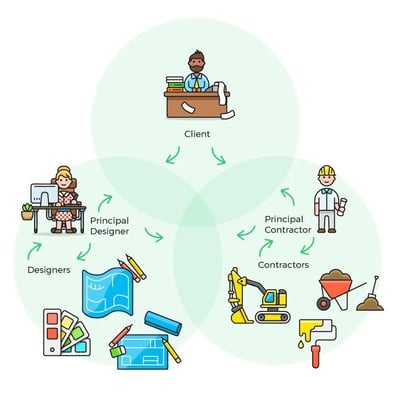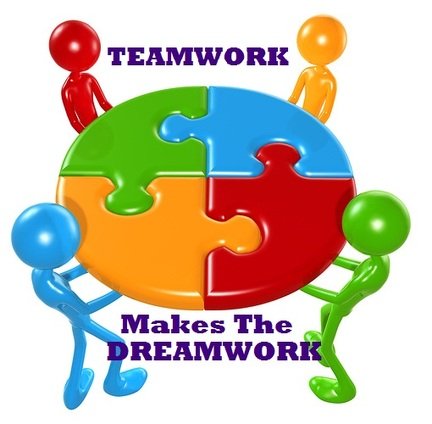Team Work Makes The Dream Work
How many times have you screamed at the TV when watching football (other sports are available) ‘just pass the ball’ or ‘he’s open, what are you doing you ***!’? Seemingly these overpaid footballers are more content to show off their so-called solo fancy footwork than actually work as a team.
 Team work is key in so many situations from the seemless (just about) prepping, cooking, serving up, clearing away of the ten course-5 hour Christmas dinner to orchestrating a family weekend jam-packed with the three kids parties, a family bbq at the in-laws, little Jimmy’s football tournament and don’t forget to walk the dog. In these situations, everyone has a role to play to ensure everything goes to plan or just about anyway (Little Jimmy getting stung by a wasp at the in-laws bbq and Grandad dropping the brussel sprouts at Christmas can’t be helped can it!!) This week’s Toolbox Talk summarises the CDM regulations which have a huge emphasis on team work to ensure a project runs smoothly and safely.
Team work is key in so many situations from the seemless (just about) prepping, cooking, serving up, clearing away of the ten course-5 hour Christmas dinner to orchestrating a family weekend jam-packed with the three kids parties, a family bbq at the in-laws, little Jimmy’s football tournament and don’t forget to walk the dog. In these situations, everyone has a role to play to ensure everything goes to plan or just about anyway (Little Jimmy getting stung by a wasp at the in-laws bbq and Grandad dropping the brussel sprouts at Christmas can’t be helped can it!!) This week’s Toolbox Talk summarises the CDM regulations which have a huge emphasis on team work to ensure a project runs smoothly and safely.
What Are The CDM Regulations?

CDM regulations came into being in 1994 though have since been updated, with the current rules being in place since 2015. CDM stands for Construction (design and management) regulations and are a hugely important set of guidelines that must be implemented in all construction projects whether you are a one man band working on a domestic project to an enormous corporation working on an equally enormous development and whether a job lasts an hour to a long-term project of a number of years. The regulations highlight the high-risk job that is construction and set about to reduce the risks through focusing on team work, careful planning and concentrating on health and safety by identifying hazards at an early stage. The Working Well Together Campaign which was established in 2008 works alongside the CDM regs in terms of the emphasis on joined up team thinking to enable the health and safety risks to be eliminated, ultimately eradicating the awful statistic that one construction worker in the UK dies every week!
What Do The CDM Regs Say?

As with your orchestration of that busy family weekend or that Xmas dinner, CDM give distinct roles to ensure projects are planned safely from start to finish. Duties are placed on the client, principle designer, principle contractors, designers and contractors. Principle roles are given when there is more than one contractor or designer to ensure there is a lead that will coordinate everyone on site. Ensuring there is a process of consulting and engaging with all parties, providing the right information, to the right people at the right time is key according to CDM regs. Workers must have relevant skills, knowledge, experience and training to carry out roles including supervision based on risk assessment findings and an induction process. Planning carried out by principle designers must involve safe systems of work with hazards removed or risk assessments implemented where risks cannot be removed fully. Relevant paperwork must be provided and explained to all involved and where projects last more than 500 person-days (30 working days with more than 20 workers) HSE notification must be submitted. On top of the policies and risk assessments you will also need pre-construction information, construction phase plan and a health and safety file.
Other General CDM Site Requirements
Other rules to bear in mind are ensuring there is suitable and sufficient site access and egress including safe pedestrian and traffic routes (as separate as possible) that are adequately lit. Vehicles must be used, towed and loaded safety, using vehicle marshalls where appropriate. Excavations, scaffolds, ladders and mobile elevating units must be confirmed as suitable for the task and checked before use. Hazardous substances or explosives must be stored and transported securely and used safely. It is the responsibility of everyone on site to take care of the tools, PPE and most importantly your own safety and that of others. Staying alert to spot and report and signs of danger or potential risks as well as noticing signs of trespassers or unauthorised access is also a huge part of running a safe site.
Stay Connected
Joined up thinking between all parties on site and coordinating work as a team is so important in every line of work but when the risks are as high as they are on a construction site, it is even more important to be aware of what is going on. As I mentioned earlier and it is almost common sense, providing the right information, at the right time, for the right people will keep everyone connected, the site running smoothly and ultimately reduce the risks.

